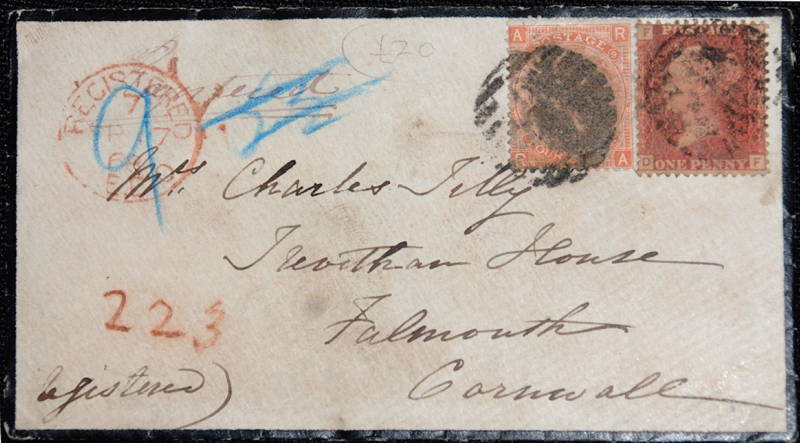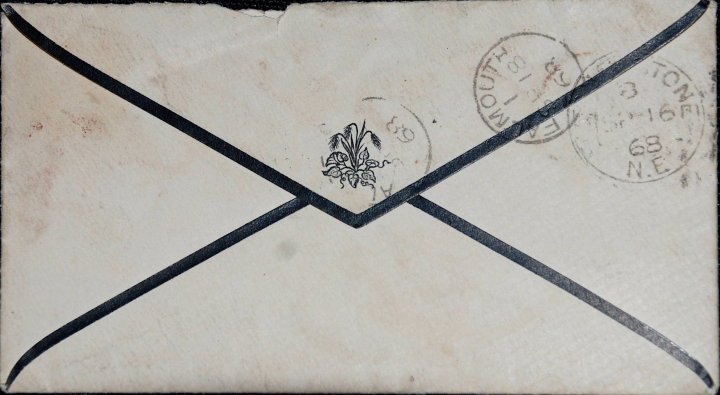Anecdotes about the poor not being able to accept death notices for lack of funds touched the heartstrings of many a Victorian and, along with other tales of hardship, helped to usher in the Penny Post. Epidemics, high child mortality rates, and poor sanitation made death — particularly early death — an integral part of Victorian life. Charlotte Brontë, for example, is the only one of six siblings to live beyond the age of thirty. Queen Victoria’s forty-year widowhood and wearing of mourning weeds made mourning rituals popular among all social classes. In an age concerned with the rituals and religious significance of death and dying, customs, appearances, and spectacle made up the process of Victorian grieving.
The Victorians marked loss with postmortem photography (posing the dead to look alive to peaceful), keepsake mementos (e.g. a lock of hair turned into a piece of jewelry), extravagant funerals, and death notices. There were strict rules on mourning etiquette — what one wore, what one did or did not do, and how one communicated the news of death. Black-edged stationery informed friends and relatives of the loss of a loved one. Once a letter weighing up to 1/2 ounce could travel anywhere in the UK for only a penny, mourning letters typically came encased in black-edged envelopes to guarantee security and protection from the elements (rain and snow).


Mourning stationery envelope with address and reverse side. [Click on thumbnails for larger images.]
Victorian literature, which quintessentially features emotion-laden death scenes, also records the arrival of death notices bringing news of inheritance as well as loss. In Charlotte Brontë’s Jane Eyre (1847), the heroine learns of the death of her Uncle Eyre and her sizeable inheritance in the same missive. Dickens and Thackeray in, respectively, Nicholas Nickleby (1839) and Vanity Fair (1848), signal death via the arrival of a black-bordered letter in the daily post. Ambitious Becky Sharp gleefully anticipates Rawdon’s windfall from Old Sir Pitt Crawley’s death when a “letter, with a huge black border and seal, was accordingly dispatched by Sir Pitt Crawley to his brother the colonel, in London” (517). More typically, “the black-bordered tell of grief” (7) as Dickens and his assistant editor W. H. Wills relay in their discussion of tell-tale envelopes crammed in London mailbags in Household Words.

A black-edged letter, designed to gently prepare the receiver for news of the grave, appears in Richard Redgrave’s narrative painting The Poor Teacher (1844), later called The Governess. The central figure is a pale and sad though pretty young woman dressed in black, holding a black-edged letter. The setting appears to be a schoolroom where one child, kept inside to learn her lessons, gazes wistfully at the other two pupils, playing outside on a sunlit terrace. Telling details help the reader to understand the governess’s sadness. The sheet music on the piano, “Home Sweet Home,” suggests the death notice comes from the governess’s home. This detail, combined with the black-edging of the letter, informs the reader that someone in her family has died. Her downcast eyes appear to hold back her tears.
Other paintings of the period, such as George Elgar Hicks’s Woman’s Mission: Companion of Manhood (1863), feature the black-edged missive and the mourning envelope with a black ”X” printed across its reverse side. The torn envelope lying on the floor of the distraught husband’s feet suggests his urgency in opening the mourning letter while his hand covering his face speaks to his shock and grief. The painting — which is the central panel in a triptych that depicts the ideal Victorian woman’s roles as loving mother to her child (Guide to Childhood), devoted wife to her husband (this panel), and dutiful daughter to her aged father (Comfort of Old Age) — shows death’s ubiquity as well as how the black-edged letter became an emissary of loss.
Victorians used black-edged stationery for up to a year following the death of a close relative. The fact that black-edged missives appear not only among extant correspondence but as a central trope in the art and literature of the period indicates that the letter is a key part of the Victorian mourning ritual. That the mourning letter becomes central, even iconographic, may be attributable to postal reform.
Bibliography
Dickens, Charles and W. H. Wills. "Valentine's Day at the Post Office." Household Words: A Weekly Journal (March 30, 1850): 7-12.
Golden, Catherine J. Posting It: The Victorian Revolution in Letter Writing. Gainesville: University Press of Florida, 2009.
Thackeray, William Makepeace. Vanity Fair: A Novel Without a Hero. Ed. John Sutherland. Illus. W. M. Thackeray. Oxford: Oxford University Press, 1983.
Last modified 8 July 2010